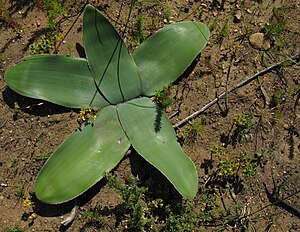Crossyne
| Crossyne | ||||||||||||
|---|---|---|---|---|---|---|---|---|---|---|---|---|

|
||||||||||||
| Systematics | ||||||||||||
|
||||||||||||
| Scientific name | ||||||||||||
| Crossyne | ||||||||||||
| Salisb. |
The plant genus crossyne belongs to the subfamily Amaryllidoideae within the family of the Amaryllis (Amaryllidaceae). The only two species are found only in winter rain areas of the Capensis .
Description and ecology
Appearance and leaves
The Crossyne species grow as perennial herbaceous plants that reach heights of up to 50 centimeters. They form onions as persistence organs, which have a diameter of 10 to 13 centimeters and usually do not protrude from the ground. The onions are covered by brittle, tan-colored onion skins (tunica). In these geophytes , the leaves are dried out during the flowering period in the dry season and fresh leaves only sprout again after the flowering period.
The mostly four to six only basal and more or less two rows arranged, more or less prostrate leaves are sessile. The simple leaf blades are broadly belt-shaped and have parallel veins. The leaf margin has long, bristle hairs ( trichomes ). The underside of the leaf may be covered with reddish spots.
Inflorescences and flowers
The flowering time in South Africa is between March and May. The strong inflorescence stem is relatively short with a length of 5 to 28 cm. 30 to 220 flowers stand together in a spherical, dold-like inflorescence with a diameter of 10 to 40 cm . In the budding state, two elongated, membranous bracts (called spathe) envelop the inflorescence; they are bent back during anthesis and then soon wither. The cross-section of the triangular and relatively long flower stalks are yellow in Crossyne flava and red in Crossyne guttata , this contributes to the attractiveness of the inflorescence.
The relatively small flowers are hermaphroditic, strongly to weakly zygomorphic and threefold. The six equally shaped bracts have grown together to form a short tube. The free areas of the bracts are narrow, oblong-lanceolate and bent back. The bracts are blackish-chestnut colored or old pink to light yellow. The six bent back or spread out, more or less identical stamens protrude above the flower envelope. The stamens inserted in the perigone tube are thread-like and widened at their base and fused to form a short tube. The anthers are dorsifix. The bisulculate pollen grains have a prickly exine . Three carpels are an egg-shaped, dreikammerigen under constant ovary grown. Each ovary chamber contains two to four unitegmic ovules . The thin, downward-curved stylus ends with a tiny three-column scar. The fragrant flowers are pollinated by insects. In crossyne flava , it is known that cross-pollination is required.
Fruits and seeds
The two genera Boophone and Crossyne differ particularly in the shape of the capsule fruits and seeds .
The egg-shaped, loculicidal capsule fruits have conspicuous, transverse nerves. The three edges of the capsule fruits are ribbed. The pericarp is paper-like. The egg-shaped seeds with a diameter of about 5 mm are reddish green and fleshy. The seed coat is covered with stomata . The integument and embryo are green. The whole, perfectly spherical fruit stand acts as a steppe roller ( Chamaechorie ) and thus ensures the seeds can spread.
Chromosome number
The basic chromosome number is x = 11.
Systematics
The genus name crossyne was 1866 Richard Anthony Salisbury in The Genera of Plants , p 116 first published . The two species were formerly known as Boophone flava and Boophone guttata in the genus Boophone . They were published in 1994 by Dietrich Müller-Doblies and Ute Müller-Doblies in De Liliifloris notulae: 5. Some new taxa and combinations in the Amaryllidaceae tribe Amaryllideae from arid southern Africa , In: Feddes Repertorium , Volume 105, pp. 331-363 in die reactivated genus Crossyne Salisb. classified.
The genus Crossyne belongs to the subtribe Strumariinae from the tribe Amaryllideae in the subfamily Amaryllidoideae within the family Amaryllidaceae . It used to be part of the Liliaceae family.
There are only two crossyne - types :
- Crossyne flava (WFBarker ex Snijman) D.Müll.-Doblies & U.Müll.-Doblies (Syn .: Boophone flava W.F.Barker ex Snijman ): It thrives in the winter rain area of the South African provinces of North Cape and Western Cape . It is rated “Least Concern” in the Red List of Endangered Plant Species in South Africa.
- Crossyne guttata D.Müll.-Doblies & U.Müll.-Doblies (Syn .: Amaryllis guttata L. , Boophone guttata (L.) Herb. , Amaryllis ciliaris L. , Boophone ciliaris (L.) Herb. , Crossyne ciliaris ( L.) Salisb. ): It only thrives in winter rain areas in the South African province of Western Cape. It is rated “Least Concern” in the Red List of Endangered Plant Species in South Africa
swell
- John C. Manning, Peter Goldblatt, Dee Snijman: The Color Encyclopedia of Cape Bulbs , 2002, Timber Press, Portland. ISBN 0-88192-547-0 : Crossyne on pp. 111–113 (section description and occurrence)
- Emily Smith, April 27, 2009: Crossyne Datasheet at Gateway to African Plants . (Section description)
Individual evidence
- ^ Crossyne at Tropicos.org. Missouri Botanical Garden, St. Louis, accessed February 8, 2012.
- ↑ Crossyne in the Germplasm Resources Information Network (GRIN), USDA , ARS , National Genetic Resources Program. National Germplasm Resources Laboratory, Beltsville, Maryland. Retrieved February 8, 2012.
- ^ DA Snijman, JE Victor, 2004: Crossyne flava , In: National Assessment: Red List of South African Plants . Retrieved February 8, 2012
- ^ DA Snijman, JE Victor, 2004: Crossyne guttata , In: National Assessment: Red List of South African Plants . Retrieved February 8, 2012